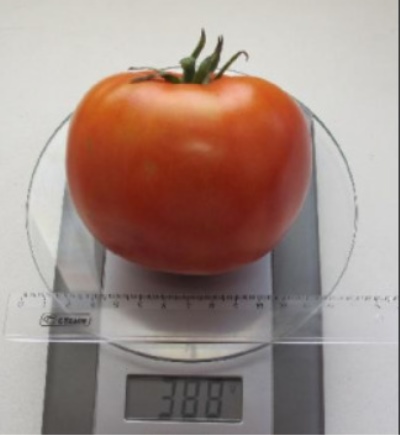
- Authors: Myazina L.A.
- Year of approval: 2007
- Category: grade
- Growth type: determinant
- Appointment: fresh consumption, for pickling and preserving, for juice, for ketchup and tomato paste
- Ripening period: mid-season
- Ripening time, days: 105-110
- Growing conditions: for open ground, for film greenhouses
- Bush size: undersized
- Bush height, cm: 55-70
The ever-increasing popularity of low-growing tomatoes arouses a genuine interest of gardeners in novelties and time-tested varieties. One of these is the determinant Bogatyr variety, intended for cultivation in film, glass and polycarbonate greenhouses, as well as in the open field. Large fruits have excellent taste and a wide range of applications - fresh consumption, cooking juices, sauces, tomato pastes, preparing summer and winter salads.
Breeding history
The originator of the variety is the famous breeder Lyubov Anatolyevna Myazina, the author of more than 25 varieties and almost 40 hybrids of tomatoes. The variety was registered in the State Register of Breeding Achievements in 2007.
Description of the variety
Low-growing, medium-leafed bushes (55-70 cm) are covered with medium-sized leaves of a classic green color. The usual yellow flowers are collected in simple inflorescences. Fruits are attached in clusters on an articulated peduncle.
Features and advantages of the variety:
no need for tying;
large-fruited with limited sizes;
crack resistance and excellent taste;
high yield, strong immunity, unpretentiousness.
Among the shortcomings, they note a weak protection against sudden temperature changes and increased requirements for the composition of the soil.
The main qualities of the fruit
Large (from 150 g) flat-round slightly ribbed fruits, green in an immature state, become bright red, glossy, very attractive outwardly.
Taste characteristics
The fleshy juicy low-seeded pulp has a medium consistency, at the break it gleams with sugar crystals. The dense skin prevents cracking and allows the fruit to be transported over long distances.
Ripening and fruiting
The tomato belongs to the mid-ripening category, the ripening period is 105-110 days.
Yield
The hero gives stable yields - 2.2 kilograms from one bush, good agricultural technology provides at least 3-4.5 kg per plant.
The timing of planting seedlings and planting in the ground
In mid-March, seedlings are sown, and planting in the ground occurs after 60-65 days.

Growing tomato seedlings is an extremely important process, because it largely depends on whether the gardener will be able to harvest at all. All aspects must be taken into account, from seedbed preparation to planting in the ground.
Landing scheme
To obtain a stable and full-fledged crop, the originator recommends following the 40x60 cm planting pattern.

Growing and care
It will take two months to grow Bogatyr's seedlings, after which it is ready for transplantation to a permanent place.Before this, hardening should be carried out - the plants must be accustomed to the temperature of the external environment, its daily fluctuations and the sun's rays, aggressive in spring and early summer.
For transplanting, the soil in the greenhouse is prepared in advance. These activities begin in late autumn, when the land is cleared of plant and household residues. This is followed by the introduction of organic matter for digging - manure, humus, compost, bird droppings. In the spring, fresh manure is not recommended - it not only can burn weak roots, but the benefits from it are much less than from humus.
This is explained simply - despite the fact that it contains much more useful substances, its heavy structure makes it difficult to work with the soil, it is full of active weed seeds that will surely germinate in the soil, and it also contains helminth eggs, harmful pathogens. At the same time, rotted manure at the age of two has already passed the necessary stage of fermentation, turned into a loose substance, smelling of earth, and is suitable for all types of plants. Humus makes the ground loose, breathable and aerated.
The hero develops well in fertile light soil, especially after onions and carrots, as well as cucumbers and legumes. However, these parameters are taken into account only when landing in open ground. In the greenhouse, no one grows onions and carrots, but cucumbers are planted, so you can swap them with tomatoes. Low-growing bushes do not need to be tied up, which eliminates the need for the gardener to organize supports or trellises. In the prepared hole, an earthen mixture is prepared with the addition of humus, wood ash, superphosphate, and young plants are planted. The soil around the stem is compacted and well spilled with settled water. The next day, the wet soil must be loosened to avoid the formation of a hard crust. Further care consists in watering, weeding, fertilizing and preventive treatments




A plant needs different micronutrients at each stage of growth. All fertilizers can be divided into two groups: mineral and organic. Folk remedies are often used: iodine, yeast, bird droppings, eggshells.
It is important to observe the rate and period of feeding. This also applies to folk remedies and organic fertilizers.
Disease and pest resistance
The tomato has good resistance to top rot and other diseases, but to guarantee full fruiting, preventive treatments with insecticides and fungicides are recommended.


Growing regions
The variety is adapted for cultivation throughout Russia. These are the Northern, North-Western, Central, Volgo-Vyatka, TsChO, North Caucasian, Middle Volga, Lower Volga, Ural, West Siberian, East Siberian, Far Eastern regions.

























































































